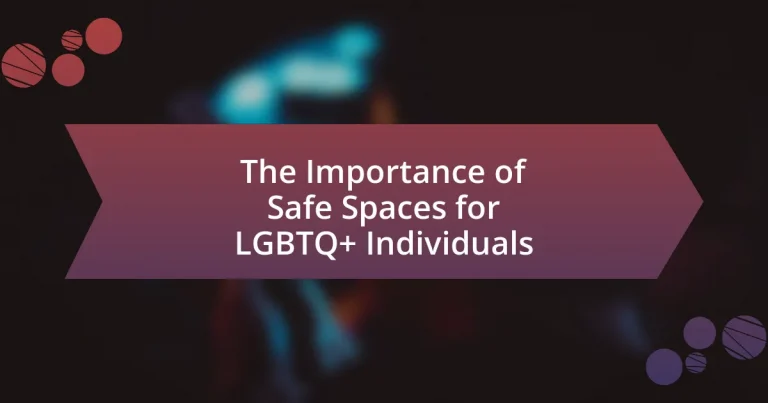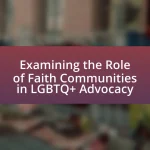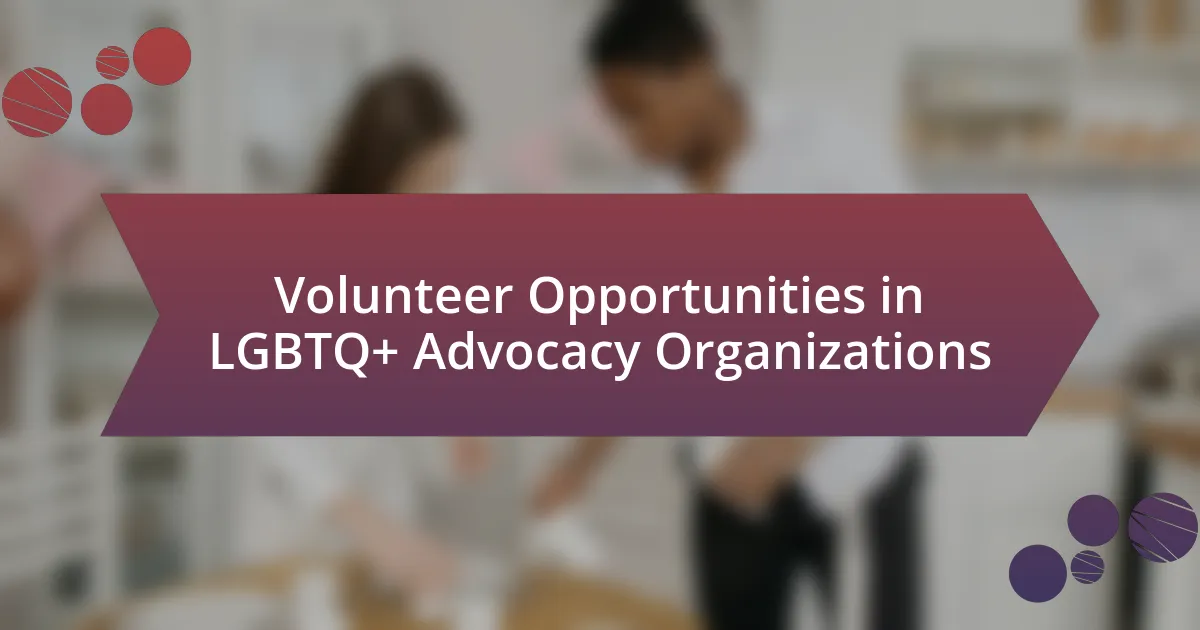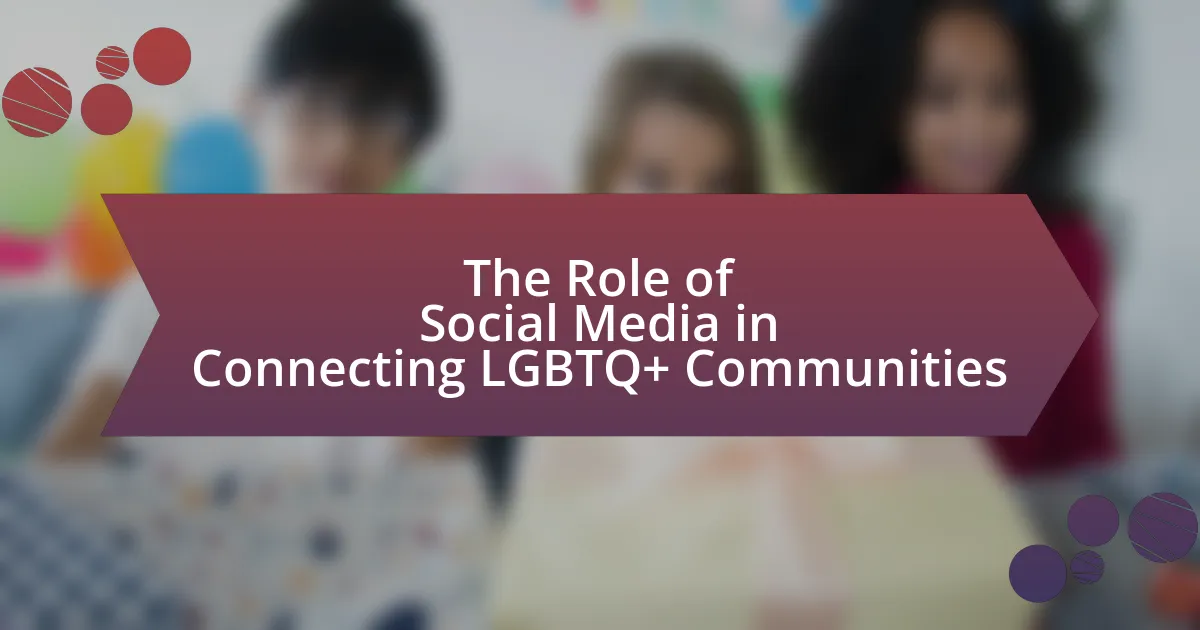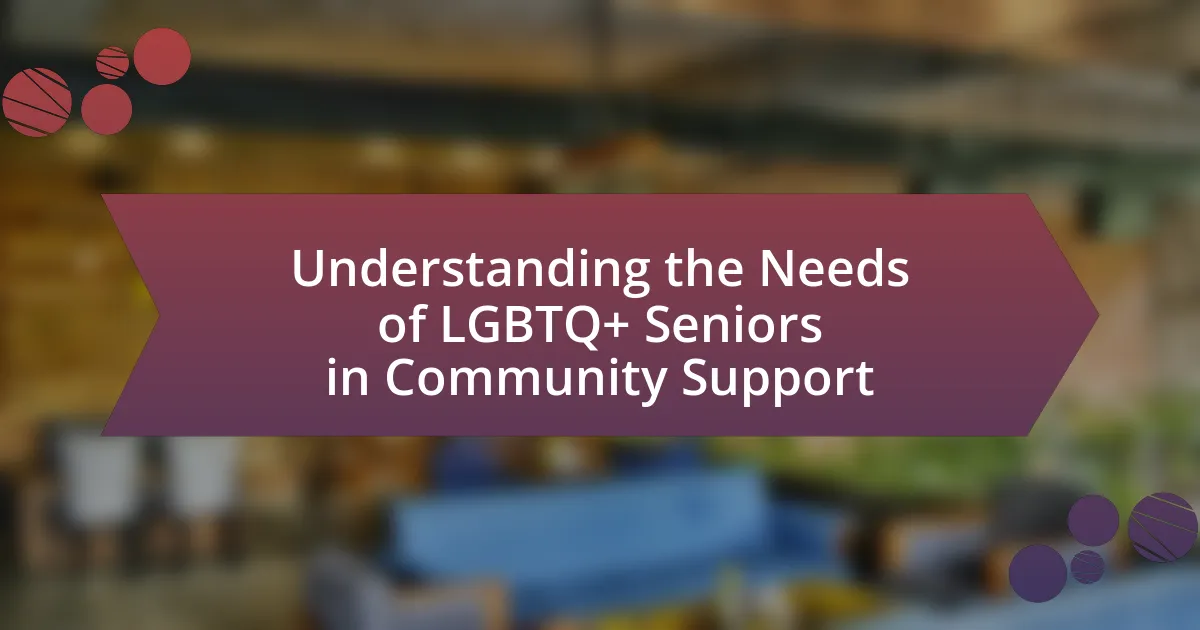Safe spaces for LGBTQ+ individuals are environments that allow for the expression of identities without fear of discrimination or harassment, significantly contributing to mental well-being. These spaces foster community, acceptance, and emotional support, which are essential for reducing feelings of isolation and anxiety among LGBTQ+ individuals. The article explores the definition, importance, and various types of safe spaces, highlighting their role in promoting mental health, reducing stigma, and fostering inclusivity. It also addresses the challenges faced by these spaces, including societal attitudes and legal issues, while emphasizing the need for continuous evolution and feedback to meet the changing needs of the LGBTQ+ community.

What are Safe Spaces for LGBTQ+ Individuals?
Safe spaces for LGBTQ+ individuals are environments where they can express their identities without fear of discrimination or harassment. These spaces provide emotional support, foster community, and promote acceptance, allowing individuals to engage openly with others who share similar experiences. Research indicates that safe spaces significantly contribute to the mental well-being of LGBTQ+ individuals, reducing feelings of isolation and anxiety. For instance, a study published in the Journal of Homosexuality found that participants who engaged in supportive environments reported higher levels of self-esteem and lower levels of depression.
Why are Safe Spaces essential for LGBTQ+ communities?
Safe spaces are essential for LGBTQ+ communities because they provide a supportive environment where individuals can express their identities without fear of discrimination or violence. These spaces foster a sense of belonging and acceptance, which is crucial for mental health and well-being. Research indicates that LGBTQ+ individuals face higher rates of mental health issues, such as depression and anxiety, often stemming from societal stigma and discrimination. Safe spaces mitigate these effects by offering resources, community support, and a platform for advocacy, ultimately contributing to improved psychological outcomes and resilience among LGBTQ+ individuals.
What defines a Safe Space for LGBTQ+ individuals?
A Safe Space for LGBTQ+ individuals is defined as an environment where they can express their identities without fear of discrimination, harassment, or judgment. This includes physical spaces, such as community centers or support groups, as well as virtual platforms that promote inclusivity and respect. Safe Spaces are characterized by policies that protect against hate speech and discrimination, trained staff who understand LGBTQ+ issues, and a culture of acceptance that encourages open dialogue. Research indicates that such environments significantly enhance mental well-being and reduce feelings of isolation among LGBTQ+ individuals, as highlighted in studies by the Human Rights Campaign, which found that supportive spaces lead to improved mental health outcomes.
How do Safe Spaces differ from other environments?
Safe spaces differ from other environments by providing a supportive and non-judgmental atmosphere specifically designed for marginalized groups, such as LGBTQ+ individuals. In safe spaces, individuals can express their identities and experiences without fear of discrimination or harassment, which contrasts with many public or traditional environments where such acceptance may not be present. Research indicates that safe spaces contribute to improved mental health and well-being for LGBTQ+ individuals by fostering a sense of belonging and community, as highlighted in studies like “The Role of Safe Spaces in Supporting LGBTQ+ Youth” published in the Journal of Youth and Adolescence.
What role do Safe Spaces play in mental health?
Safe spaces play a crucial role in mental health by providing environments where individuals, particularly those from marginalized communities like LGBTQ+ individuals, can express themselves without fear of judgment or discrimination. These spaces foster a sense of belonging and acceptance, which is essential for reducing anxiety, depression, and feelings of isolation. Research indicates that individuals who engage in supportive environments report higher levels of well-being and lower levels of psychological distress. For instance, a study published in the Journal of Counseling Psychology found that LGBTQ+ individuals who participated in safe spaces experienced significant improvements in mental health outcomes, highlighting the importance of these environments in promoting emotional resilience and overall mental health.
How do Safe Spaces contribute to emotional well-being?
Safe spaces contribute to emotional well-being by providing environments where individuals feel accepted, supported, and free from discrimination. These spaces foster a sense of belonging, which is crucial for mental health, particularly for marginalized groups such as LGBTQ+ individuals. Research indicates that access to safe spaces can reduce feelings of isolation and anxiety, leading to improved self-esteem and overall emotional resilience. For instance, a study published in the Journal of Homosexuality found that LGBTQ+ youth who engage in supportive environments report lower levels of depression and higher levels of life satisfaction. This evidence underscores the vital role safe spaces play in enhancing emotional well-being.
What impact do Safe Spaces have on reducing stigma?
Safe spaces significantly reduce stigma by providing environments where individuals can express their identities without fear of judgment or discrimination. These spaces foster acceptance and understanding, which in turn diminishes negative stereotypes associated with LGBTQ+ individuals. Research indicates that participation in safe spaces leads to increased self-acceptance and community support, as evidenced by a study published in the Journal of Homosexuality, which found that LGBTQ+ youth who engaged in supportive environments reported lower levels of internalized stigma and higher overall well-being.

How do Safe Spaces support LGBTQ+ individuals?
Safe spaces support LGBTQ+ individuals by providing environments where they can express their identities without fear of discrimination or harassment. These spaces foster acceptance, promote mental well-being, and encourage community building among LGBTQ+ individuals. Research indicates that safe spaces significantly reduce feelings of isolation and anxiety, as they offer support networks and resources tailored to the unique challenges faced by LGBTQ+ individuals. For instance, a study published in the Journal of Homosexuality found that participants in safe spaces reported higher levels of self-esteem and lower levels of depression compared to those who did not have access to such environments.
What types of Safe Spaces exist for LGBTQ+ individuals?
Safe spaces for LGBTQ+ individuals include community centers, support groups, online forums, educational institutions, and LGBTQ+ friendly businesses. Community centers often provide resources, events, and a welcoming environment for social interaction. Support groups offer emotional and psychological assistance, fostering a sense of belonging. Online forums create virtual safe spaces for discussion and connection, especially for those in isolated areas. Educational institutions may establish LGBTQ+ clubs and safe zones to promote inclusivity and awareness. LGBTQ+ friendly businesses often display symbols of support, creating environments where individuals feel accepted. These spaces are essential for mental health and community building, as studies show that supportive environments significantly reduce feelings of isolation and improve overall well-being among LGBTQ+ individuals.
How do community centers serve as Safe Spaces?
Community centers serve as safe spaces by providing inclusive environments where LGBTQ+ individuals can express themselves freely without fear of discrimination or harassment. These centers often offer resources such as support groups, educational programs, and social events specifically designed to foster acceptance and community among LGBTQ+ individuals. Research indicates that such environments significantly reduce feelings of isolation and increase mental well-being, as evidenced by a study published in the Journal of Homosexuality, which found that participation in community center activities correlates with improved self-esteem and social support among LGBTQ+ youth.
What role do online platforms play in creating Safe Spaces?
Online platforms play a crucial role in creating Safe Spaces for LGBTQ+ individuals by providing accessible environments for community building, support, and expression. These platforms facilitate connections among users who share similar experiences and identities, allowing for the exchange of resources, advice, and emotional support. For instance, research indicates that 70% of LGBTQ+ youth report feeling more accepted when they engage with online communities that affirm their identities. Additionally, online platforms often implement features such as privacy controls and moderation tools to protect users from harassment and discrimination, further enhancing the sense of safety and belonging.
How can Safe Spaces foster inclusivity?
Safe spaces foster inclusivity by providing environments where individuals, particularly those from marginalized communities, can express themselves without fear of discrimination or judgment. These spaces encourage open dialogue, allowing diverse voices to be heard and validated, which is essential for building a sense of belonging. Research indicates that safe spaces can significantly reduce feelings of isolation among LGBTQ+ individuals, promoting mental well-being and community engagement. For instance, a study published in the Journal of Homosexuality found that participants who engaged in safe spaces reported higher levels of self-acceptance and social support, demonstrating the effectiveness of these environments in fostering inclusivity.
What practices enhance the effectiveness of Safe Spaces?
Practices that enhance the effectiveness of Safe Spaces include establishing clear guidelines for respectful communication, providing training for facilitators on inclusivity, and fostering a culture of trust and confidentiality. Clear guidelines ensure that all participants understand the expectations for behavior, which promotes a respectful environment. Training for facilitators equips them with the skills to manage discussions sensitively and inclusively, addressing the diverse needs of LGBTQ+ individuals. Additionally, a culture of trust and confidentiality encourages open sharing, allowing individuals to express themselves without fear of judgment or repercussions. These practices collectively contribute to a supportive atmosphere that is essential for the well-being of LGBTQ+ individuals in Safe Spaces.
How can allies contribute to the creation of Safe Spaces?
Allies can contribute to the creation of Safe Spaces by actively advocating for inclusivity and respect within their communities. This involves listening to LGBTQ+ individuals, amplifying their voices, and challenging discriminatory behaviors and language. Research indicates that environments where allies are present and vocal can significantly reduce feelings of isolation among LGBTQ+ individuals, fostering a sense of belonging and safety. For instance, a study published in the Journal of Homosexuality found that supportive allies in educational settings lead to improved mental health outcomes for LGBTQ+ students.
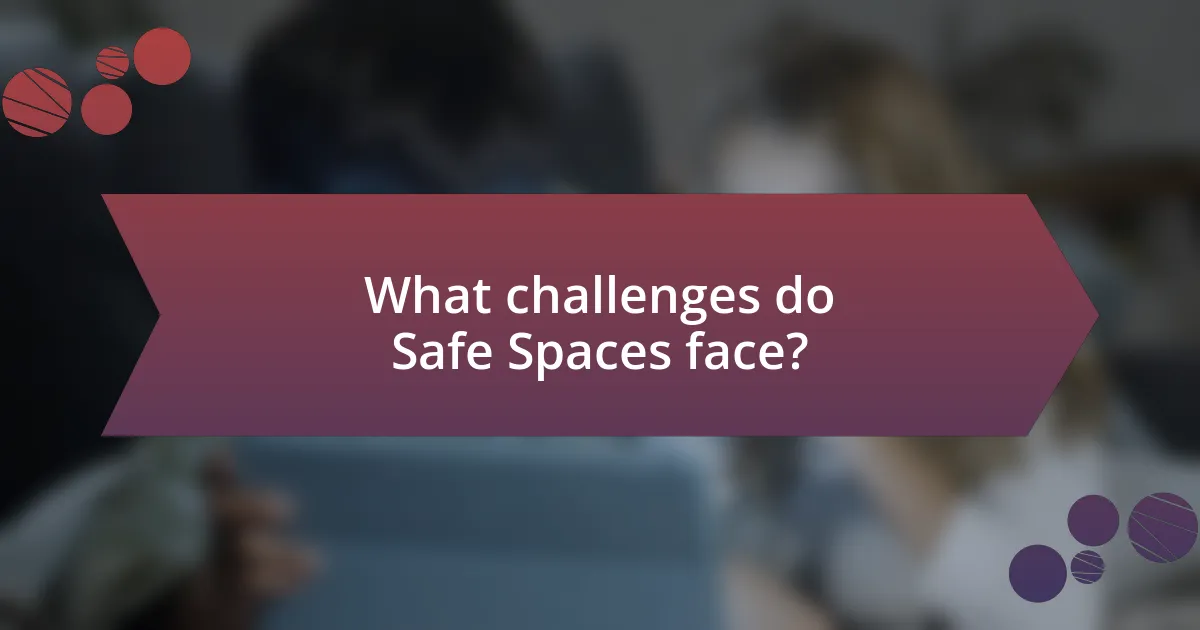
What challenges do Safe Spaces face?
Safe spaces face challenges such as funding limitations, community resistance, and the potential for tokenism. Funding limitations hinder the ability to maintain and expand these spaces, as many rely on grants or donations that may not be consistent. Community resistance can arise from misunderstandings or biases against LGBTQ+ individuals, leading to opposition or lack of support for safe spaces. Additionally, tokenism can occur when organizations create safe spaces without genuine commitment to inclusivity, undermining their effectiveness. These challenges can significantly impact the ability of safe spaces to provide the necessary support and resources for LGBTQ+ individuals.
What barriers exist in establishing Safe Spaces?
Barriers in establishing Safe Spaces include societal stigma, lack of funding, and inadequate training for facilitators. Societal stigma often leads to discrimination and hostility towards LGBTQ+ individuals, making it difficult to create an inclusive environment. Additionally, insufficient funding limits resources necessary for maintaining these spaces, which can hinder their effectiveness and accessibility. Furthermore, a lack of training for facilitators can result in unintentional harm or exclusion, undermining the purpose of Safe Spaces. These barriers collectively impede the establishment and sustainability of supportive environments for LGBTQ+ individuals.
How do societal attitudes impact the effectiveness of Safe Spaces?
Societal attitudes significantly impact the effectiveness of Safe Spaces by influencing the level of acceptance and support these environments receive. When societal attitudes are positive towards LGBTQ+ individuals, Safe Spaces can thrive as supportive environments that foster open dialogue and community building. Conversely, negative societal attitudes can lead to stigmatization and hostility, undermining the purpose of Safe Spaces and making individuals feel unsafe or unwelcome. Research indicates that in communities with high levels of acceptance, such as those with inclusive policies and representation, LGBTQ+ individuals report higher satisfaction and mental well-being in Safe Spaces, demonstrating the direct correlation between societal attitudes and the effectiveness of these environments.
What legal challenges do Safe Spaces encounter?
Safe Spaces encounter legal challenges primarily related to discrimination laws and freedom of speech issues. These spaces often face scrutiny under anti-discrimination statutes, which can lead to legal disputes when individuals claim exclusion based on sexual orientation or gender identity. For instance, in some jurisdictions, the enforcement of policies that prioritize LGBTQ+ individuals may conflict with the rights of others, leading to lawsuits that test the boundaries of civil rights protections. Additionally, Safe Spaces may confront challenges regarding their ability to limit participation based on identity, which can raise First Amendment concerns about free expression and association. Legal precedents, such as the Supreme Court’s rulings on discrimination and free speech, illustrate the complexities Safe Spaces navigate in maintaining their mission while adhering to legal standards.
How can Safe Spaces evolve to meet changing needs?
Safe Spaces can evolve to meet changing needs by incorporating feedback from the communities they serve, adapting programming, and utilizing technology. Regular assessments of the specific challenges faced by LGBTQ+ individuals, such as mental health issues or discrimination, can inform the development of targeted resources and support systems. For instance, a study by the Human Rights Campaign found that 40% of LGBTQ+ youth reported feeling unsafe at school, highlighting the need for safe environments that address these concerns through educational initiatives and peer support networks. Additionally, integrating virtual platforms can expand access to resources and community connections, ensuring that Safe Spaces remain relevant and responsive to the evolving landscape of LGBTQ+ experiences.
What innovations are being implemented in Safe Spaces?
Innovations being implemented in Safe Spaces for LGBTQ+ individuals include the integration of technology for enhanced accessibility and support, such as virtual counseling services and mobile apps that provide resources and community connections. These innovations aim to create more inclusive environments by utilizing digital platforms to reach individuals who may not have access to physical spaces. For instance, organizations like The Trevor Project have developed crisis intervention apps that offer immediate support and resources, demonstrating the effectiveness of technology in fostering safe environments.
How can feedback from LGBTQ+ individuals improve Safe Spaces?
Feedback from LGBTQ+ individuals can significantly improve Safe Spaces by ensuring that these environments meet their specific needs and concerns. By actively soliciting and incorporating feedback, organizations can identify gaps in inclusivity, address safety issues, and enhance the overall experience for LGBTQ+ individuals. Research indicates that environments designed with direct input from marginalized communities are more effective; for example, a study published in the Journal of Community Psychology found that community-driven initiatives lead to higher satisfaction and engagement levels among participants. This evidence underscores the importance of feedback in creating truly supportive and responsive Safe Spaces.
What are practical steps to create effective Safe Spaces?
To create effective Safe Spaces, organizations should implement clear guidelines that promote inclusivity and respect. Establishing a code of conduct that outlines acceptable behaviors and language fosters a welcoming environment. Training staff and participants on LGBTQ+ issues enhances understanding and empathy, which is crucial for creating a supportive atmosphere. Additionally, providing accessible resources, such as mental health support and educational materials, ensures that individuals feel safe and informed. Research indicates that environments with established norms and support systems significantly improve the well-being of LGBTQ+ individuals, as highlighted in the study “Creating Safe Spaces: The Impact of Supportive Environments on LGBTQ+ Youth” by the Williams Institute.
